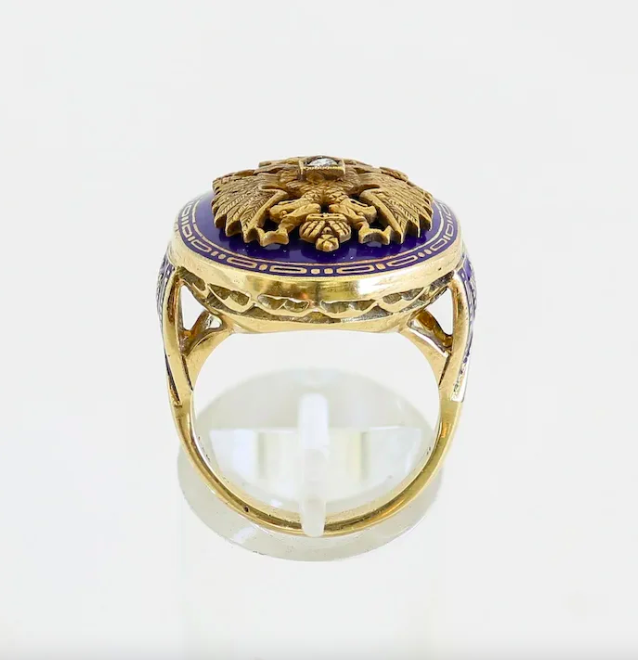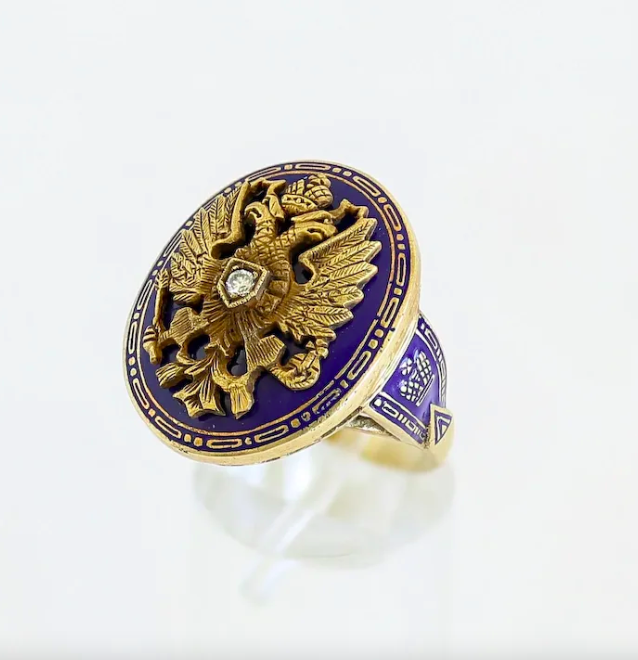Rare Vintage 14K Russian Double Eagle Enameled Ring
This is a very rare ring. It appears to be a Russian Double Eagle Crest of Arms. It is stamped 14K with cobalt blue enameling. The ring has a double eagle with a crown at the top and is set in the middle with a quality accent diamond. The eagle crest is in a burnished gold finish set against an oval cobalt blue enameled background while the rest of the setting is polished gold creating a dramatic contrast. Around the outer edge of the cobalt blue is an intricate gold design which is continued on each side of the setting with a gold crown. The ring measures 8/16ths of an inch from north to south and 3/4 inch wide. The ring would stand up on the finger 1/4 inch and is presently a size 6 3/4. Due to the enamel work we will not resize this ring. This ring can easily be worn by a lady or gentleman and is in excellent original condition. The double-headed eagle is a common symbol in heraldry and vexillology. It is most commonly associated with the Byzantine Empire, the Holy Roman Empire, the Serbian Empire, the Russian Empire and their successor states. In Byzantine heraldry, the heads represent the Emperor having authority over both secular and religious matters. It also signified the dominance of the Byzantine Emperors over both East and West. In the Holy Roman Empire's heraldry, it represented the church and the state. Several Eastern European nations adopted it from the Byzantines and continue to use it as their national symbol.
This is a very rare ring. It appears to be a Russian Double Eagle Crest of Arms. It is stamped 14K with cobalt blue enameling. The ring has a double eagle with a crown at the top and is set in the middle with a quality accent diamond. The eagle crest is in a burnished gold finish set against an oval cobalt blue enameled background while the rest of the setting is polished gold creating a dramatic contrast. Around the outer edge of the cobalt blue is an intricate gold design which is continued on each side of the setting with a gold crown. The ring measures 8/16ths of an inch from north to south and 3/4 inch wide. The ring would stand up on the finger 1/4 inch and is presently a size 6 3/4. Due to the enamel work we will not resize this ring. This ring can easily be worn by a lady or gentleman and is in excellent original condition. The double-headed eagle is a common symbol in heraldry and vexillology. It is most commonly associated with the Byzantine Empire, the Holy Roman Empire, the Serbian Empire, the Russian Empire and their successor states. In Byzantine heraldry, the heads represent the Emperor having authority over both secular and religious matters. It also signified the dominance of the Byzantine Emperors over both East and West. In the Holy Roman Empire's heraldry, it represented the church and the state. Several Eastern European nations adopted it from the Byzantines and continue to use it as their national symbol.
This is a very rare ring. It appears to be a Russian Double Eagle Crest of Arms. It is stamped 14K with cobalt blue enameling. The ring has a double eagle with a crown at the top and is set in the middle with a quality accent diamond. The eagle crest is in a burnished gold finish set against an oval cobalt blue enameled background while the rest of the setting is polished gold creating a dramatic contrast. Around the outer edge of the cobalt blue is an intricate gold design which is continued on each side of the setting with a gold crown. The ring measures 8/16ths of an inch from north to south and 3/4 inch wide. The ring would stand up on the finger 1/4 inch and is presently a size 6 3/4. Due to the enamel work we will not resize this ring. This ring can easily be worn by a lady or gentleman and is in excellent original condition. The double-headed eagle is a common symbol in heraldry and vexillology. It is most commonly associated with the Byzantine Empire, the Holy Roman Empire, the Serbian Empire, the Russian Empire and their successor states. In Byzantine heraldry, the heads represent the Emperor having authority over both secular and religious matters. It also signified the dominance of the Byzantine Emperors over both East and West. In the Holy Roman Empire's heraldry, it represented the church and the state. Several Eastern European nations adopted it from the Byzantines and continue to use it as their national symbol.









